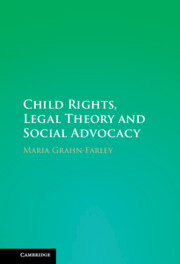Book contents
- Child Rights, Legal Theory and Social Advocacy
- Child Rights, Legal Theory and Social Advocacy
- Copyright page
- Dedication
- Contents
- Acknowledgments
- Introduction
- 1 The Child and Human Rights
- 2 The Monist Construction of the Child
- 3 The Complex Intersectionality of the Child
- 4 Heard but Unable to Speak
- 5 The Child in the Child Rights Movement
- 6 The Child in the Exception
- 7 The Monist Pull of Universalization
- 8 The Monist Child-Rights Identity and Universal Positivism
- Bibliography
- Index
Introduction
Published online by Cambridge University Press: 07 November 2024
- Child Rights, Legal Theory and Social Advocacy
- Child Rights, Legal Theory and Social Advocacy
- Copyright page
- Dedication
- Contents
- Acknowledgments
- Introduction
- 1 The Child and Human Rights
- 2 The Monist Construction of the Child
- 3 The Complex Intersectionality of the Child
- 4 Heard but Unable to Speak
- 5 The Child in the Child Rights Movement
- 6 The Child in the Exception
- 7 The Monist Pull of Universalization
- 8 The Monist Child-Rights Identity and Universal Positivism
- Bibliography
- Index
Summary
The UN Convention on the Rights of the Child created a legal subject without the possibility for children to exercise any agency in the making of their own identity. What differs between the child-rights identity based on age and a socially constructed identity, and self-identification is that age is a random event free from choice, detached from family context, delinked from any social context and disconnected from one’s self-image.
- Type
- Chapter
- Information
- Child Rights, Legal Theory and Social Advocacy , pp. 1 - 6Publisher: Cambridge University PressPrint publication year: 2024

